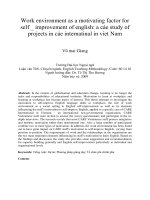MASTERING YOUR STUDY ENVIRONMENT
Bạn đang xem bản rút gọn của tài liệu. Xem và tải ngay bản đầy đủ của tài liệu tại đây (94.85 KB, 12 trang )
Do you understand what Jamie is feeling? She has conflicting goals,
studying and relaxing with her family, and she is easily distracted in the
setting she has placed herself in. Aha! There is the clue: “she has placed
herself in.” Jamie is, as all students are, responsible for creating her own
study environment, including where, when, and how she studies.
This chapter explains how to master your study environment to
improve your test scores.
Mastering Your Study Environment
47
Secret 4
M
ASTERING
Y
OUR
S
TUDY
E
NVIRONMENT
J
amie was thrilled about entering high school, but she
was unable to raise her grades to the level she and
her parents expected.
Jamie studied at the dining room table as she always
had, with her back to the living room, tuning out the noises
of the television or her parents and younger sister playing
games. She tried spending more time studying but found
that the extra time didn’t make a difference. She wanted to
learn the material her teachers assigned, but Jamie also
wanted to relax with her family.
Now that studying had become difficult for Jamie, all
sorts of things came to mind for her to do during her
study time. She visited the kitchen hunting for snacks.
She remembered chores she had not completed and
notes she needed to write. She even found herself play-
ing with the salt and pepper shakers on the table.
Jamie felt her freshman year slipping away.
ACTIVE STUDY TIME
Essential to improving your test scores is making your study time
active. Many of us approach studying in a passive way—we just absorb
facts and theories like a sponge. We may think that because we have
read the textbook, heard the lecture, and taken notes, we’re all set.
This book is about your investment in a more active role in your study
process. Let’s get to it.
Some examples of active studying include:
•
researching your tests
•
setting your goals
•
creating and implementing a study plan
•
asking questions
•
exploiting resources
•
brainstorming additional ideas and connections
•
organizing your notes
•
mastering your study environment
Consider yourself an active student at the start of each course and
each class period. It will take some practice, but you can do it.
And how do you implement active studying? Start with the right
attitude!
THE RIGHT ATTITUDE
Hey, it may seem corny, but it’s empowering to have a good attitude.
What do you think of these examples of positive attitude?
• Mae acknowledges that to be a veterinarian when she’s an adult, she will
have to work hard now, especially around exam times. Mae accepts a
commitment to hard work.
• Teddy pretends he’s a super academic athlete, shifting into active test-
training mode when a test is coming up. Teddy uses an image that will
help him enjoy his studies more.
• Phil gladly helps Tera with her French, and Tera knows how to explain
their ecology assignments in ways that Phil can understand. Phil believes
that “what goes around, comes around,” so he gets satisfaction
from helping others.
48
10 SECRETS TO ACING ANY HIGH SCHOOL TEST
• Candy takes advantage of a variety of learning opportunities: She reads
the extra assignment, looks for resources online, watches PBS, and asks
questions in class. Candy is enthusiastic and curious.
• Noi considers how to apply what she has learned in books and in class to
her life. Noi extends her knowledge to other applications.
• Drew hates making mistakes but tries to learn from them, make the best
of things, and accept that taking risks may involve failure. Drew can
turn lemons into lemonade.
Create an Attitude that Invites Success
Be sure to create the right attitude about study and especially about
reading—students do a lot of it! If you have something challenging
to read and you tell yourself, “I’ll never understand this,” chances
are that you won’t. You have conditioned yourself for failure.
Instead, condition yourself for success. Give yourself affirmations
such as:
• “No matter how hard the reading level, I will learn something
from this.”
• “I will become a better reader with each reading task.”
• “I can understand and I will remember.”
Have a positive attitude about your reading material, too. If you tell
yourself, “This is going to be boring,” you undermine your chances
for learning and enjoying. Even if you are not interested in the topic
you have to read about, remember that you are reading it for a reason:
You have something to gain. Keep your goals clearly in mind.
Remember, it’s OK to reward yourself when you have completed a
difficult reading assignment. (And the knowledge you gain from the
reading is also its own reward.)
What if you have mastered the right attitude, but still can’t con-
centrate on your studies? Maybe you should look into mastering brain
interference, too!
WHAT EXACTLY IS BRAIN
INTERFERENCE?
Can you focus on the task in front of you? Do you know how to elim-
inate brain interference?
Mastering Your Study Environment
49
In Study Smarts, authors Judi Kesselman-Turkel and Franklynn
Peterson suggest that the most effective tip for concentrating is
to eliminate “brain interference”—whatever distracts you from
your ability to focus. Brain interference can range from being
in love to wondering if your sister’s birthday is on Monday or
Tuesday.
Try these suggestions to free your brain from interference:
• If you are hungry, cold, hot, or sleepy, take care of it.
• If you are a nibbler, have healthy snacks nearby before you start
to study.
• If you have nervous habits, such as twirling your hair or biting your
nails, ask yourself if they calm you or distract you. If they distract
you, think of a non-distracting substitute, such as holding a high-
lighter in your hand.
• If you need to have music or noise in the background, try Mozart
or white noise. Music by Mozart has been proven to adjust brain-
waves to their most receptive state; studying while listening to the
Sonata for Two Pianos in D Major the night before exams
improved students’ test scores! For white noise, try turning on
a fan to create a consistent background noise that will mask
any interrupting noises (TV in another room, your little
brother’s play group) that could occur as you settle in for a study
session.
• If you keep thinking about irrelevant details (deadlines, questions
to ask your coach, lyrics to a song), write them down, make lists,
and keep a written or electronic calendar so that you can focus on
studying instead.
• If you are studying courses with similar concepts, such as physics
and calculus, you should separate them on your study schedule to
keep vocabulary and formulas clear.
• If you are experiencing emotional interference—you are angry at
your teacher or in trouble with your dad—talk it out with a friend,
parent, or mentor.
• If you are anxious about passing a chemistry course, your anxiety
may actually help motivate you to remember better. However, if
you are anxious about a dentist appointment, turn your thinking
back to studying.
50
10 SECRETS TO ACING ANY HIGH SCHOOL TEST
NURTURE CONCENTRATION
Do you know someone who can concentrate with laser-like attention?
Some of us can do this naturally, but most of us need to set the stage
for good concentration. Since good concentration leads to more effi-
cient studying, which leads to more effective test taking, consider
these steps:
1. Make yourself a special study spot: Roy studies on the side table in
his mom’s home office. (Read more on special study spots later in this
chapter.)
2. Choose one goal at a time—a small, specific, and reasonable
task: Gia is memorizing the first half of the Periodic Table of the Ele-
ments.
3. Prepare the space for work—gather a dictionary, calculator,
and extra paper—and then begin: Jason made sure he had 3 sharp-
ened pencils for his practice exam.
4. When you finish a task, leave your study spot and take a
break: Rachel walked to the kitchen for some orange juice and a chat
with her dad.
5. Gradually increase the amount of work you want to get done
in a study session: Tomoyuki discovered that, with practice and
breaks, he could study for his SATs for an entire afternoon without los-
ing concentration.
The idea is to reward yourself for good concentration. Too many of us
work until we can’t concentrate any longer and aren’t getting much
done, and then we take a break. When you think about it, this is
merely rewarding bad concentration.
SOURCES IN CYBERSP
SOURCES IN CYBERSP
ACE
ACE
Concentration Sites
Check out this URL for a list of links to sites and articles on how
to concentrate when studying. There are some excellent tips to try.
•
www.howtostudy.org/resources/conc/index.htm
Mastering Your Study Environment
51









